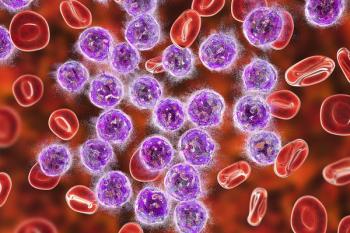
- ONCOLOGY Vol 24 No 2
- Volume 24
- Issue 2
‘Vitamin R’ and Its Younger Siblings
No branch of oncology has been more attuned to the vision of new genetically engineered targeted therapies than the field of hematopoietic malignancies. Ujjani and Cheson have produced a masterful summary of one extremely important component of the targeted therapy revolution-the realm of monoclonal antibodies directed against malignant lymphoma surface antigens.[1] The review presents a wonderful update and a glimpse of future potentially curative macromolecular cocktails. It is an attractive vision.
No branch of oncology has been more attuned to the vision of new genetically engineered targeted therapies than the field of hematopoietic malignancies. Ujjani and Cheson have produced a masterful summary of one extremely important component of the targeted therapy revolution-the realm of monoclonal antibodies directed against malignant lymphoma surface antigens.[1] The review presents a wonderful update and a glimpse of future potentially curative macromolecular cocktails. It is an attractive vision.
Progenitor Compound
The review begins appropriately with the progenitor compound for which US Food and Drug Administration (FDA) approval in 1997 first heralded the arrival of monoclonals to the oncologic prime time-the chimeric anti-CD20 antibody rituximab (Rituxan).[2] This construct was first approved for the treatment of relapsed and refractory low-grade B-cell non-Hodgkin lymphoma (NHL), and recognizes the CD20 surface antigen found on approximately 95% of B-cell malignancies. After demonstrating its value as a single agent, rituximab was subsequently combined with multiple different cytotoxic regimens and produced substantial outcome improvement for most of these combinations.[3-5] Rituximab has now become a relatively nontoxic constituent of dozens of individual regimens meant for induction, consolidation, and maintenance of response in both aggressive and indolent B-cell malignancies. So ubiquitous is rituximab that devotees have begun to refer to this monoclonal as “vitamin R”-an essential conutrient in the medical oncologist’s anti–B-cell arsenal.
After reviewing early studies, mechanisms of action, and modes of use, the authors then turn their attention to other more recent members of the anti–B-cell monoclonal cohort including other chimeric and fully humanized forms of immunoglobins targeting other CD20 epitopes, as well as ligands for CD22, CD23, CD40, CD80, and other similar binding proteins. For most of the candidate therapeutic molecules, the available preclinical evidence suggests multiple different signaling physiologies involving various transduction pathways, complement activation steps, and immunologic stimulatory features. The data also suggest that the effects may sometimes be improved through the use of certain chemical and radiologic side chains.
Radioimmunotherapy
Although drug-antibody cancer constructs are still in their infancy, the field of radiolabeled antibody therapy or radioimmunotherapy is now entering the mainstream with two powerful FDA-approved anti–B-cell targeted radiopharmaceuticals: tositumomab/131I-tositumomab (Bexxar) and 90Y-ibritumomab tiuxetan (Zevalin). The first to enter large-scale clinical trials was 131I-tositumomab. Similar to rituximab, this agent has specificity for the CD20 B-cell surface antigen. 131I-tositumomab has received FDA approval for the treatment of relapsed and refractory CD20-positive follicular lymphoma.[6]
Multiple published studies of these two agents show overall response rates in the 60% to 80% range, with 20% to 40% complete responses in this second-line setting. Kaminski and colleagues also performed a single-institution phase II trial using this radiopharmaceutical for the first-line treatment of advanced-stage follicular lymphoma.[7] They recently updated this experience with a report at the 2009 annual meeting of the American Society of Hematology (ASH) summarizing the 10-year data on their group of 76 patients treated in the initial cohort. They reported a 97% overall response rate with a respectable 57 of 76 (75%) achieving a front-line complete response. The median duration of response for the group was approximately 6 years, with a full 40% remaining progression-free at 10 years. For those patients achieving a complete response, the median progression-free survival (PFS) was 10.9 years with overall survival > 80%.
Thus, for at least some patients, a single course of front-line treatment with anti–B-cell targeted radiopharmaceuticals may produce a durable response lasting over a decade with minimal significant side effects other than temporary dose-related hematosuppression. This is very good news indeed for patients who fear endless rounds of debilitating chemotoxicity.
FIT Data
Further support for this family of monoclonal antibody–based radiopharmaceuticals can be seen in recent reports from the multicenter European First-line Indolent Trial (FIT) cooperative, which evaluated the ability of a different anti-CD20 monoclonal radiolabeled with the pure beta-emitter 90Y via the chelating side-arm tiuxetan.[8,9] Unlike 131I-tositumomab, which could be observed directly using a gamma camera, 90Y-ibritumomab tiuxetan required a surrogate 111In-labeled antibody to visualize bioclearance patterns and verify safe biodistribution. However, the relative consistency of the clearance patterns allows 90Y-ibritumomab tiuxetan to be dosed using a straightforward mCi/kg metric, substantially simplifying the infusion logistics.
Moreover, the clinical trial design chosen by the FIT group allowed the use of the radiopharmaceutical as postchemotherapy consolidation after many different chemotherapy regimens. This randomized 419-patient trial of radioimmunotherapy for front-line consolidation resulted in a 2-year improvement in median PFS (36.5 vs 13.3 months; P < .0001) compared to the group not receiving radiopharmaceutical consolidation. This use as postchemotherapy consolidation emphasizes the use of radioimmunotherapy as a facilitative component of the antilymphoma regimen, able to significantly improve conventional chemotherapy responses.
Although the exact role of the additional rituximab received as a component of the ibritumomab tiuxetan regimen has not yet been fully elucidated, the FDA voted in September 2009 to approve 90Y-ibritumomab tiuxetan for front-line postchemotherapy consolidation. In agreement with this suggestion, the treatment algorithm proposed by the National Comprehensive Cancer Network committee evaluating lymphoma management listed radioimmunotherapy as a level 1 recommendation for front-line consolidation in chemotherapy responders with follicular B-cell NHL. The data from the FIT group are not yet mature enough to show any hint of a survival difference despite the strongly significant differences in PFS in favor of the group receiving radiopharmaceutical. The group is still being followed closely.
Targeted Combinations and Health-Care Economics
The Ujjani and Cheson review intimates a fruitful direction for future antineoplastic research: the use of multiple concurrent or sequential targeted therapeutics that, due to their limited toxicity, can be safely combined with other antineoplastics to produce powerful and safe new tumor-control regimens. The use of immunoglobulin moieties as building blocks in the construction of new antilymphoma regimens shows that they may best be viewed not as chemotherapy replacements but as chemotherapy turbochargers. Although results have not yet been reported, an important phase III trial (Southwest Oncology Group [SWOG] 0016/Cancer and Leukemia Group B [CALGB] 50102) comparing CHOP (cyclophosphamide, doxorubicin, vincristine, prednisone)/131I-tositumomab to CHOP-R (CHOP plus rituximab) for previously untreated follicular lymphoma has closed, and results are anxiously awaited.[10]
Is it possible that a mixture of relatively nontoxic biologicals such as targeted monoclonal constructs could be combined in such a way that, together with chemotherapeutics, cytokines, and cellular manipulations like stem cell transplant regimens, these building blocks may finally yield a curative regimen for advanced-stage indolent lymphoma?[11] This is certainly an appealing prospect. However, the costs to society and to individuals for such combination therapies would be nontrivial. The recent emergence of health-care economics as an important element of academic medical evaluation is now yielding publications that attempt to quantify comparative effectiveness of various regimens in terms of the cost per year of survival.
Gabriel et al recently showed, for instance, that at least in Europe, the cost-effectiveness (cost per quality-adjusted remission year, in euros) for 90Y-ibutixmomab tiuxetan compared quite favorably to costs for rituximab for patients with relapsed low-grade NHL (approximately €22,235 for radioimmunotherapy vs €80,077 for rituximab).[12] The ability to demonstrate cost-effectiveness in the United States will clearly depend on many other factors including negotiated costs for alternative therapies and associated physician charges. However, it does not seem unreasonable that a universal American health-care package might include multiple antibody-based therapeutics as components for long-term lymphoma control. Buchegger et al have hypothesized that combinations of optimized antibody treatments together with more conventional cytotoxic therapies may lead to “the prospect of cure.”[13]
Conclusions
Given the high costs of combining these therapies, outcome improvement would have to be very substantial. However, the realistic potential for curative therapy for a previously incurable medical condition affecting tens of thousands of patients has moved markets and societal sentiments in the past. The development of biologic regimens incorporating vitamin R and its monoclonal siblings may be an important step in the development of new curative pathways for malignant lymphoma and related malignancies.[14]
Financial Disclosure:Dr. Macklis is a member of the speakers group for and has received research support from Spectrum Pharmaceuticals.
References:
References
1. Ujjani C, Cheson B: Monoclonal antibodies in advanced B-cell lymphomas. Oncology (Williston Park) 24:156-166, 2010.
2. Hainsworth JD: First-line and maintenance treatment with rituximab for patients with indolent non-Hodgkin’s lymphoma. Semin Oncol 30:9-15, 2003.
3. Herold M, Haas A, Sroch S, et al: Rituximab added to first-line mitoxantrone, chlorambucil, and prednisolone chemotherapy followed by interferon maintenance prolongs survival in patients with advanced follicular lymphoma: An Eastern German Study Group hematology and oncology study. J Clin Oncol 25:1986-1992, 2007.
4. Van Oers MH, Klasa R, Marcus RE, et al: Rituximab maintenance improves clinical outcome of relapsed/refractory follicular non-Hodgkin’s lymphoma in patients with and without rituximab during induction: Results of a prospective randomized phase III intergroup trial. Blood 108:3295-3301, 2006.
5. HiddemanW, Kneba M, Dreyling M, et al: Frontline therapy with rituximab added to the combination of cyclophosphamide, doxorubicin, vincristine, and prednisone (CHOP) significantly improves the outcome for patients with advanced-stage follicular lymphoma compared with therapy with CHOP: Results of a prospective randomized study of the German Low-Grade Lymphoma Study Group. Blood 1006:3725-3732, 2005.
6. Kaminski MS, Zelenetz AD, Press OW, et al: Pivotal study of iodine-131 tositumomab for chemotherapy-refractory low-grade or transformed low-grade B-cell non-Hodgkin’s lymphoma. J Clin Oncol 19:3918-3928, 2001.
7. Kaminski M, Tuck M, Estes J, et al: Tositumomab and iodine I-131 tositumomab for previously untreated, advanced-stage, follicular lymphoma: Median 10 year follow-up results (abstract 3759). Blood 114(22), 2009.
8. Witzig TE, Gordon LI, Camarillas F, et al: Randomized controlled trial of yttrium-90-labeled ibritumomab tiuxetan radioimmunotherapy versus rituximab immunotherapy for patients with relapsed or refractory low-grade, follicular, or transformed B-cell non-Hodgkin’s lymphoma. J Clin Oncol 20:2453-2463, 2002.
9. Morschhauser F, Radford J, van Hoof A, et al: Phase III trial of consolidation therapy with yttrium-90-labeled ibritumomab tiuxetan compared with no additional therapy after first remission in advanced follicular lymphoma. J Clin Oncol 26:5156-5164, 2008.
10. Press O, Unger J, Maloney D, et al: An update of a phase II trial of CHOP followed by tositumomab/iodine I-131 tositumomab (Bexxar) for front-line treatment of advanced stage, follicular lymphoma: SWOG 9911 (abstract 352). Blood 106(11), 2005.
11. Otte A, Van de Wiele C, Dierckx RA: Radiolabeled immunotherapy in non-Hodgkin’s lymphoma treatment: The next step. Nucl Med Commun 30:5-15, 2009.
12. Gabriel A, Hänel M, Wehmeyer A, et al: Advantages in cost effectiveness of Zevalin radioimmunotherapy vs rituximab immunotherapy in patients with relapsed or refractory follicular non-Hodgkin’s lymphoma (abstract 296). Onkologie 28(suppl 3), 2005.
13. Buchegger F, Press OW, Delaloye B, et al: Radiolabeled and native antibodies and the prospect of cure of follicular lymphoma. Oncologist 13:657-667, 2008.
14. Macklis RM, Hagenbeek A: frontline postchemotherapy consolidation with 90Y-Zevalin RIT: Finally an ideal role for RIT in lymphoma management? Am J Hematol Oncol 7(5):190-192, 2008.
Articles in this issue
almost 16 years ago
ONCOLOGY Continuing Medical Education February 2010almost 16 years ago
HDAC Inhibitors in Cancer Carealmost 16 years ago
Clarifying the Role of Neoadjuvant Therapy in Breast Canceralmost 16 years ago
HDAC Inhibitors: Much to Learn About Effective Therapyalmost 16 years ago
HDAC Inhibitor Research: Still in Its Infancyalmost 16 years ago
Monoclonal Antibodies in Advanced B-cell Lymphomasalmost 16 years ago
Fighting a Smarter War on Canceralmost 16 years ago
Proteomics Study Reveals a Protein Tied to Taxane ResistanceNewsletter
Stay up to date on recent advances in the multidisciplinary approach to cancer.





